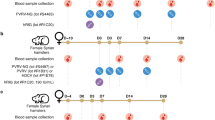Summary
We examined the possibility of simplifying the currently recommended immunization schedule against rabies. Four groups of 11 healthy volunteers were each immunized with either one, two, four, or eight doses of 0.1 ml human diploid cell vaccine (HDCV) intradermally on 1 single day. Antibody titers in serum were determined using a rapid fluorescent focus inhibition test. Geometric mean antibody titers 10, 30 and 90 days after immunization were all >0.5 IU/ml, which is considered protective. A dose-proportional increase in the geometric mean antibody titer was observed for all four groups. However, at each dose level, at least 1 of the 11 volunteers on day 30 and 2 of the 11 volunteers on day 90 had insufficient antibody titers <0.5 IU/ml. Single-day immunization against rabies with HDCV vaccine cannot be recommended because of the unacceptably high failure rate.
Similar content being viewed by others
Abbreviations
- DEV:
-
Duck-embryo-vaccine
- GMT:
-
geometric mean titer
- HDCV:
-
human diploid cell vaccine
- IU:
-
international units
References
Ajjan N, Soulebot JP, Triau R, Biron G (1980) Intradermal immunization with rabies vaccine. JAMA 244:2528–2531
Anderson LJ, Sikes RK, Langkop CW, Mann JM, Smith JS, Winkler WG, Deitch MW (1980) Postexposure trial of a human diploid cell strain rabies vaccine. J Infect Dis 142:133–138
Aoki FY, Tyrell DA, Hill LE (1975) Immunogenicity and acceptability of a human diploid-cell culture rabies vaccine in volunteers. Lancet I:660–662
Bernard KW, Roberts MA, Summer J, Winkler WG, Mallonee J, Baer GM, Chaney R (1982) Human diploid cell rabies vaccine: effectiveness of immunization with small intradermal or subcutaneous doses. JAMA 247:1138–1142
Burridge MJ, Baer GM, Summer JW, Sussman O (1982) Intradermal immunization with human diploid cell rabies vaccine. JAMA 248:1611–1614
Cox JH, Schneider LG (1976) Prophylactic immunization of humans against rabies by intradermal inoculation of human diploid cell culture vaccine. J Clin Microbiol 3:96–101
Field evaluation of pre-exposure use of human diploid cell rabies vaccine (1983). MMWR 32:601–603
Harverson G, Chantapong W (1984) Use of post-exposure intradermal rabies vaccination in a rural mission hospital. Lancet II:313–315
Lemon SM, Miller RN, Pang LW, Prier RE, Bernard KW (1984) Failure to achieve predicted antibody responses with intradermal and intramuscular human diploid cell rabies vaccine. Lancet I:1098–1100
Nicholson KG, Cole PJ, Turner GS, Harrison P (1979) Immune response of humans to a human diploid cell strain of rabies virus vaccine: lymphocyte transformation, production of virus neutralizing antibody, and induction of interferon. J Infect Dis 140:176–182
Nicholson KG, Prestage H, Cole PJ, Turner GS, Bauer SP (1981) Multisite intradermal antirabies vaccination: immune response in man and protection of rabbits against death from street virus by post-exposure administration of human diploid cell strain rabies vaccine. Lancet II:915–918
Recommendation of the Immunization Practises Advisory Committee (ACIP) (1981) Supplementary statement on rabies vaccine and serology testing. MMWR 30:535–536
Recommendation of the Immunization Practises Advisory Committee (ACIP) (1982) Supplementary statement on pre-exposure rabies prophylaxis by the intradermal route. MMWR 31:280–285
Smith JS, Yager PA, Baer GM (1973) A rapid reproducible test for determining rabies neutralizing antibody. Bull WHO 48 [Suppl]:535–541
Turner GS, Aoki FY, Nicholson KG, Tyrell DA, Hill LE (1976) Human diploid cell strain rabies vaccine: rapid prophylactic immunization of volunteers with small doses. Lancet I:1379–1381
Warrell MJ, Suntharasamai P, Sinhaseni A, Phanfung R, Vincent-Falquet J-C, Bunnag D, Warrell DA, Viravan C, Udomsakdi D, Xueref C, Nicholson KG, Hainasuta T (1983) An economical regimen of human diploid cell strain anti-rabies vaccine for post-exposure prophylaxis. Lancet II:301–304
Warrell MJ, Nicholson KG, Chanthavanich P, Sinhaseni A, Xueref C, Suntharasamai P, Warrell DA, Viravan C, Phanfung R, Vincent-Falquet J-C (1984) Multi-site intradermal and multi-site subcutaneous rabies vaccination: improved economical regimens. Lancet I:874–876
Warrell MJ, Warrell DA, Chanthavanich P, Sinhaseni A, Pouradier-Dutweil X, Phanfung R, Nicholson KG, Suntharasamai P, Viravan C, Chiewbambroongkiat MK, Xueref C, Udomsakdi D (1985) Economical multiple-site intradermal immunisation with human diploid-cell-strain vaccine is effective for postexposure rabies prophylaxis. Lancet I:1059–1062
Working group II (1978) Vaccine potency requirements for reduced immunization schedules and preexposure treatment. Dev Biol Stand 40:268–270
Author information
Authors and Affiliations
Rights and permissions
About this article
Cite this article
Täuber, M.G., Putzi, R., Fuchs, P. et al. High rate of insufficient antibody titers after single-day immunization with human diploid-cell-strain vaccine against rabies. Klin Wochenschr 64, 518–521 (1986). https://doi.org/10.1007/BF01713059
Received:
Accepted:
Published:
Issue Date:
DOI: https://doi.org/10.1007/BF01713059



